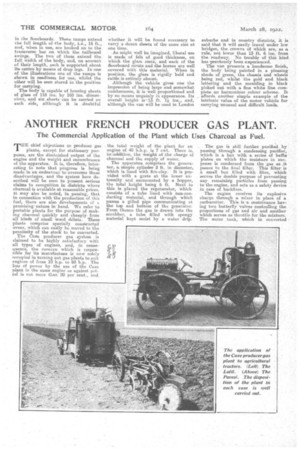FOR CARRYING PLATE GLASS.
Page 11

Page 12

If you've noticed an error in this article please click here to report it so we can fix it.
A Body With Several Unique Features, Mounted on a Thornycroft Chassis.
CERTAIN classes of loads carried by commercial vehicles demand special types of bodies, some on account of their bulky nature, and others on account of their liability to damage by breakage. In the latter category plate glass can im; doubtedly be included, since it requires special precautions to be taken during transit to avoid damage which would. invariably involve considerable financial loss.
At one time plate glass was transported by those engaged in the fitting and replacement of Windows, showcases and the like in horse vehicles, which were fitted with a special type of body, incorporating a cranked rear axle in order to give a low loading lino, but, in conformity with the general trend of movement by mechanical power, quite a considerable proportion of this material 18 now conveyed by motor vehicles. What is more, it has been found that fewer breakages occur when carrying the glaze by motor than by horsed vehicles. At least, that has been the experience of the National Provincial Plate Glass and General Insurance Co., Ltd., Ludgate Hill, London, E.C.4, who have used a motor vehicle for this class of work for some time past. In fact, their satisfaction with this mode of transportation can readily be gauged when we state that a week ago they took delivery of the vehicle which we illustrate on this page from the works of J. I. Thornycroft and Co., Ltd., at Basingstoke,
The body is fitted on a 3' type 4-ton Thornycroft chassis and possesses several interesting features, notable amongst which are the specially shaped front4 and the method of housing the ramps up which the men carrying the glass into the body interior have to walk.
It will be seen from one of the pictures that a V-fronted structure built of canvas on a skeleton framework protrudes above the driver's cab. This serves as a windcutter and, besides avoiding uneven air pressure on tall aheets of glass, also materially reduces air resistance, with a consequent reduction ih petrol consumption.
The rigid body Bides extend the full height of the body arid form a flat top with the sloping horsei of the interior, over which waterproof canvas is stretched and fastened down by rope to hooks on the outer sides of the body. These top supports can be raised slightly so as to take higher plates.
Two ramps are accommodated in the body interior in the lower part of the spaces between the body sides and the sloping horses, and they can easily be withdrawn or replaced on rollers fitted
in the floorboards. These ramps extend the full length of the body, i.e., 14 ft., and, when in use, are hooked on to the -transverse bar on which the tailboard swings. The two of them extend the. full width of the body, and, on account of their length, each is supported about its centre by means of drop legs. In one of the illustrations one of the ramps is shown in readiness for use, whilst the other will be seen stored in the position for carrying.
The body is capable of housing sheets of glass of 118 ins. by 168 ins. dimen. sions, and six sheets can be carried on each side, although it is doubtful whether it will he found necessary to carry a dozen sheets of the same size at one time.
As might well be imagined, liberal use is made of fel: of good thickness, on which the glass rests, and each of the floorboard struts and the horses are well covered with this material. When in position, the glass is rigidly held and rattle is entirely absent. Although the vehicle gives one the impression of being large and somewhat cumbersome, it is well proportioned and by no means ungainly in appearance. Its overall height is '13 ft. 14 ins., and, although the van will be used in London suburbs and in country districts', it is said that it will easily travel under low bridges, the crowns of which are, as a rule, not lower than 13 ft. 6 ins, from the roadway. No trouble of this kind has previously been experienced. The van presents a handsome finish, the body, being painted in a pleasing shade of green, the chassis and wheels being red, whilst the gold and black lettering and the moulding in black picked out with a. fine white line complete an harmoniouscolour scheme. It , affords another simple example of the intrinsic value of the motor vehicle for carrying unusual and difficult loads.
































